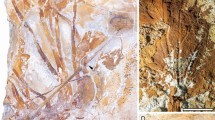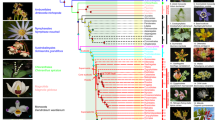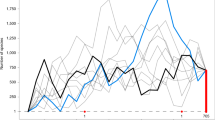Abstract
Phylogenetic analyses have identified the water lilies (Nymphaeales: Cabombaceae and Nymphaeaceae), together with four other small groups of flowering plants (the ‘ANITA clades’: Amborellaceae, Illiciales, Trimeniaceae, Austrobaileyaceae), as the first diverging lineages from the main branch of the angiosperm phylogenetic tree1,2,3,4, but evidence of these groups in the earliest phases of the angiosperm fossil record has remained elusive. Here we report the earliest unequivocal evidence, based on fossil floral structures and associated pollen, of fossil plants related to members of the ANITA clades. This extends the history of the water lilies (Nymphaeales) back to the Early Cretaceous (125–115 million years) and into the oldest fossil assemblages that contain unequivocal angiosperm stamens and carpels. This discovery adds to the growing congruence between results from molecular-based analyses of relationships among angiosperms and the palaeobotanical record. It is also consistent with previous observations that the flowers of early angiosperms were generally very small5 compared with those of their living relatives.
This is a preview of subscription content, access via your institution
Access options
Subscribe to this journal
Receive 51 print issues and online access
$199.00 per year
only $3.90 per issue
Buy this article
- Purchase on Springer Link
- Instant access to full article PDF
Prices may be subject to local taxes which are calculated during checkout

Similar content being viewed by others
References
Qiu, Y.-L. et al. The earliest angiosperms: evidence from mitochondrial, plastid and nuclear genomes. Nature 402, 404–407 (1999).
Qiu, Y.-L. et al. Phylogeny of basal angiosperms: analyses of five genes from three genomes. Int. J. Plant Sci. 161 (Suppl. 6), S3–S27 (2000).
Soltis, P. S., Soltis, D. E. & Chase, M. W. Angiosperm phylogeny inferred from multiple genes as a tool for comparative biology. Nature 402, 402–404 (1999).
Kuzoff, R. A. & Gasser, C. S. Recent progress in reconstructing angiosperm phylogeny. Trends Plant Sci. 5, 330–336 (2000).
Friis, E. M., Pedersen, K. R. & Crane, P. R. Angiosperm floral structures from the Early Cretaceous of Portugal. Pl. Syst. Evol. 8 (Suppl.), 31–49 (1994).
Magallón, S., Crane, P. R. & Herendeen, P. S. Phylogenetic pattern, diversity and diversification of eudicots. Ann. Missouri Bot. Gard. 86, 297–372 (1999).
Frumin, S. & Friis, E. M. Magnoliid reproductive organs from the Cenomanian–Turonian of north-western Kazakhstan: Magnoliaceae and Illiciaceae. Plant Syst. Evol. 216, 265–288 (1999).
Gandolfo, M. A., Nixon, K. C. & Crepet, W. L. in Monocots: Systematics and Evolution (eds Wilson, K. I. & Morrison, D. A.) 44–51 (CSIRO, Melbourne, 2000).
Friis, E. M., Pedersen, K. R. & Crane, P. R. Early angiosperm diversification: the diversity of pollen associated with angiosperm reproductive structures in Early Cretaceous floras from Portugal. Ann. Missouri Bot. Gard. 86, 259–296 (1999).
Friis, E. M., Pedersen, K. R. & Crane, P. R. Reproductive structure and organization of basal angiosperms from the Early Cretaceous (Barremian or Aptian) of Western Portugal. Int. J. Plant Sci. 161 (Suppl. 6), S169–S182 (2000).
Zbyszewski, G., Manupella, G. & Da Veiga Ferreira, O. Carta geológica de Portugal na escala de 1/50 000. Notícia explicativa da folha 27-A Vila Nova de Ourém (Serviços Geológicos de Portugal, Lisbon, 1974).
Doyle, J. A. & Hickey, L. J. in Origin and Early Evolution of Angiosperms (ed. Beck, C. B.) 139–206 (Columbia Univ. Press, New York, 1976).
Penny, J. H. J. An Early Cretaceous angiosperm pollen assemblage from Egypt. Special Papers Palaeontol. 35, 121–134 (1986).
Doyle, J. A. Revised palynological correlations of the lower Potomac Group (USA) and the Cocobeach sequence of Gabon (Barremian–Aptian). Cretaceous Res. 13, 337–349 (1992).
Hughes, N. F. & McDougall, A. B. Barremian-Aptian angiospermid pollen records from southern England. Rev. Palaeobot. Palynol. 65, 145–151 (1990).
Doyle, J. A. & Robbins, E. I. Angiosperm pollen zonation of the continental Cretaceous of the Atlantic Coastal Plain and its application to deep wells in the Salisbury Embayment. Palynology 1, 43–78 (1977).
Hughes, N. F. The Enigma of Angiosperm Origins (Cambridge Univ. Press, Cambridge, 1994).
Rey, J. Recherches géologiques sur le Crétacé inférieur de l'Estremadura (Portugal). Serviços Geológicos de Portugal, Memórias (Nova Série) 3 21, 1–477 (1972).
Endress, P. K. & Igersheim, A. Gynoecium structure and evolution in basal angiosperms. Int. J. Plant Sci. 161 (Suppl. 6), S211–S223 (2000).
Saporta, G. D. Flore fossile du Portugal. Nouvelles contributions à la flore Mésozoique. Accompagnées d'une notice stratigraphique par Paul Choffat (Imprimerie de l'Academie Royale des Sciences, Lisbon, 1894).
Mohr, B. & Friis, E. M. Early angiosperms from the Aptian Crato Formation (Brazil), a preliminary report. Int. J. Plant Sci. 161 (Suppl. 6), S155–S167 (2000).
Les, D. H. et al. Phylogeny, classification and floral evolution of water lilies (Nymphaeaceae; Nymphaeales): A synthesis of non-molecular, rbcL, matK, and rDNA data. Syst. Bot. 24, 28–46 (1999).
Williamson, P. S. & Schneider, E. I. Cabombaceae. in The Families and Genera of Vascular Plants. II Flowering plants– Dicotyledons. Magnoliid, Hamamelid and Caryophyllid Families (eds Kubitzki, K., Rohwer, J. G. & Bittrich, V.) 157–161 (Springer, Berlin, 1993).
Schneider, E. l. & Williamson, P. S. Nymphaeaceae. in The Families and Genera of Vascular Plants. II Flowering plants – Dicotyledons. Magnoliid, Hamamelid and Caryophyllid Families (eds. Kubitzki, K., Rohwer, J. G. & Bittrich, V.) 486–493 (Springer, Berlin, 1993).
Bessey, C. E. The phylogenetic taxonomy of flowering plants. Ann. Missouri Bot. Gard. 2, 109–164 (1915).
Takhtajan, A. Flowering Plants. Origin and Dispersal (Oliver & Boyd, Edinburgh, 1969).
Drinnan, A. N., Crane, P. R. & Hoot, S. B. Patterns of floral evolution in the early diversification of non-magnoliid dicotyledons (eudicots). Plant Syst. Evol. 8 (Suppl.), 93–122 (1994).
Friis, E. M., Crane, P. R. & Pedersen, K. R. in Evolution and Diversification of Land Plants (eds Iwatsuki, K. & Raven, P. H.) 121–156 (Springer, Tokyo, 1997).
Brenner, G. J. & Bickoff, I. S. Palynology and the age of the Lower Cretaceous basal Kurnub Group from the coastal plain to the northern Negev of Israel. Palynology 16, 137–185 (1992).
Acknowledgements
We thank P. K. Endress and J. Schönenberger for valuable comments and help; and P. von Knorring for preparing the reconstruction of the fossil flower. The work was supported by grants from the Swedish Natural Science Foundation (to E.M.F.), the Carlsberg Foundation (to K.R.P. and E.M.F.), the Danish Natural Science Research Council (to K.R.P.) and the US National Science Foundation (to P.R.C.).
Author information
Authors and Affiliations
Corresponding author
Rights and permissions
About this article
Cite this article
Friis, E., Pedersen, K. & Crane, P. Fossil evidence of water lilies (Nymphaeales) in the Early Cretaceous. Nature 410, 357–360 (2001). https://doi.org/10.1038/35066557
Received:
Accepted:
Issue Date:
DOI: https://doi.org/10.1038/35066557
This article is cited by
-
Auxin controls circadian flower opening and closure in the waterlily
BMC Plant Biology (2018)
-
An unusual association of hadrosaur and therizinosaur tracks within Late Cretaceous rocks of Denali National Park, Alaska
Scientific Reports (2018)
-
Phylogenetic Analyses of Cretaceous Fossils Related to Chloranthaceae and their Evolutionary Implications
The Botanical Review (2018)
-
Water lilies as emerging models for Darwin’s abominable mystery
Horticulture Research (2017)
-
Notonuphar antarctica, an extinct water lily (Nymphaeales) from the Eocene of Antarctica
Plant Systematics and Evolution (2017)
Comments
By submitting a comment you agree to abide by our Terms and Community Guidelines. If you find something abusive or that does not comply with our terms or guidelines please flag it as inappropriate.



